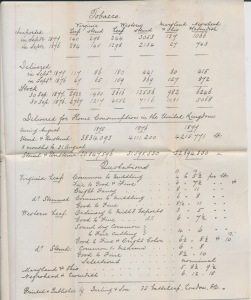Economic theory extols the virtue of trade and many anthropologists credit trade with being among the human inventions that most advanced civilization and material wealth. Stamps facilitated trade as their invention and use made communications easier, and ease of communications is one of the conditions that improves trade. Throughout the Nineteenth Century it was agricultural products that were the most traded and tobacco was one of the most widely traded and transported agricultural commodities. Tobacco was addictive so its market was ever expanding and unresponsive to changes in taste and fashion. Tobacco grew only in certain climates far removed from Europe where it was needed and tobacco required little care after harvesting making it an ideal crop for transport and trade. Rats didn't eat it and it could be stored for a long time. The letter illustrated above ( and we scanned the folded letter and then opened it out so you can read it) is an example of the kind of interrelatedness o
Monthly Archives: April 2022
- Read more »
- Posted April 19, 2022in NewsRead more »
Most special stamps relate to postal use and postal purposes. Stamps such as Airmails are higher denominated stamps and the extra revenue is used to defray the cost of the class of service that is being used. But War Tax stamps are a different animal entirely-they are a country using its postal service to generate revenue for another purpose, in this case war funding. The first War Tax stamps were issued by Spain in the late Nineteenth Century and War Tax stamps have been issued as late as 1974 in Bahrain. But by far the most significant use of War tax stamps was in the British Commonwealth for raising revenue for WW I. Most of the Colonial issues are overprints, but Canada produced different stamps for War Tax one of which is illustrated here. They way War Tax stamps produced revenue was that after a certain date all letters had to bear a tax stamp in addition to the postage stamp and all revenue from the sale of the tax stamps went to the war effort. The United States had a tidier solu
- Posted April 09, 2022in NewsRead more »
Among the most interesting specializations in our hobby are the stamps of Canada and especially the issue of 1880-1890 that are called the "Large Queens". The name that philatelists have given this set refers to their physical relationship to the set of stamps that came after them. These stamps are large-the next issues was much smaller. Large Queens have several interesting philatelic points going for them, primarily the fact that there are so many varieties to collect. The stamps themselves are well printed and attractive and the varieties ensure that a specialist never comes to end of items to acquire. There are perf varieties and paper varieties, especially three of the stamps being issued on Laid paper (all of the Laid paper varieties are rare). There are watermarked varieties as these stamps were issued on paper as it could be purchased and for different printings that sometimes meant paper that was watermarked. And there are shades galore. In fact the 15c value is printed in a c





